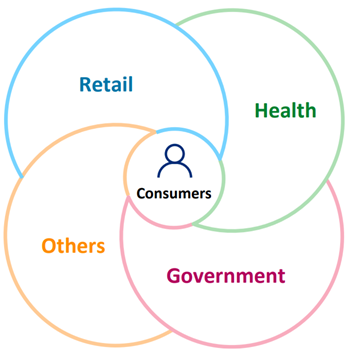<p>By: Krystal Register, MS, RDN, LDN, Vice President, Health & Well-being, FMI</p><p><img src="https://www.fmi.org/images/default-source/blog-images/hwb-blog-may-2024-small-image.tmb-large-350-.png?Culture=en&sfvrsn=ea8e7887_1" style="float:right;margin:10px;" class="-align-right" alt="HWB Blog May 2024 Small Image" sf-size="178904" />Consumers across the country are gaining access to healthy benefits as dollars to spend on their overall health and well-being. These "healthy benefits" are made available through public and private funding and are delivered in varied ways as part of many different programs. Consumers seem to appreciate these extra incentives aimed at improving overall health. <span style="font-size:0.8em;">(NOTE: Use of the term "healthy benefits" here is in reference to these collective programs and services.)</span></p><p>While some of these programs have been around for many years, the multi-billion-dollar market for healthy benefits is growing fast. As new opportunities rapidly emerge, retailers are seeking ways to understand the entire ecosystem in order to accept various cards, partner with payers and processors, carry products and services covered and ultimately provide seamless solutions for customers.</p><h5>Programs</h5><p>In addition to programs funded by the federal government, insurers and employers are expanding healthy benefits offerings. Programs and their sources of funding include:</p><ul><li>SNAP/WIC – federal government (includes GusNIP)</li><li>HSA/FSA/HRA – individuals and employers</li><li>Medicare Advantage – health insurance payors (may receive government funding as well)</li><li>Nascent programs* – government, insurance payors, non-profits, employers, others</li></ul><p style="font-size:0.8em;">*These include Medicaid waivers and food as medicine programs such as food prescriptions and medically tailored meals.</p><h5>Ecosystem</h5><p>The general ecosystem puts the consumer at the intersection of healthcare providers and insurance payers, government, retail and many others to include non-profit organizations, employers and issuers. The flow of information, programs, funds, prescriptions, products and services is complex and competitive.</p><img src="https://www.fmi.org/images/default-source/blog-images/hwb-blog-may-2024.png?sfvrsn=fcfb547c_1" style="margin-top:5px;margin-bottom:40px;" alt="HWB Oliver Wyman Infographic" sf-size="100" /><h5>Products and Services</h5><p>In general, benefits are intended to promote preventive care, wellness activities and overall health improvement. Consumers can spend their benefits on various health-related products and services depending on the program. Examples can include over-the-counter items, select groceries, medical devices, counseling services, nutrition education, fitness equipment, pet food, household supplies, gas, transportation, utilities, etc. Spending can also be restricted to certain products or connected to approved lists.</p><h5>Challenges</h5><p>There are many potential challenges in this complicated ecosystem, particularly in the areas of: enrollment for the customer, activation of the card, data security, knowledge of available benefits and what items are on an approved product list, retailer acceptance of the card at the point of sale, technology limitations, and troubleshooting with the right entity when a question arises.</p><h5>Opportunity</h5><p>There is a growing opportunity for retailers to connect with food as medicine interventions that provide a combination of medically tailored meals, produce prescriptions, food boxes, personalized counseling and other services intended to prevent or manage disease. Healthy benefits programs are multiplying, and the local grocery store has a supportive role to play. Retailers can champion the growth of these programs while building customer loyalty as a destination for health and well-being in the communities they serve.</p><p>To better understand the complexities and opportunities, FMI has partnered with Oliver Wyman to create an on-going series of resources for members. The foundational materials from 2023 include a recorded digital seminar: <a href="https://www.fmi.org/forms/store/ProductFormPublic/understanding-healthy-benefits-cards" target="_blank" rel="noreferrer noopener">Understanding Healthy Benefits Cards</a> and white paper titled: <a href="https://www.fmi.org/forms/store/ProductFormPublic/healthy-benefits-wellbeing" target="_blank" rel="noreferrer noopener">How Accepting Healthy Benefits Support Customer Wellbeing</a>.</p><p>Continuing to build on this foundation, a follow up digital seminar specifically explored funding pools and accelerated growth. The recording is now available to FMI members.</p><p><a href="https://www.fmi.org/forms/store/ProductFormPublic/HealthyBenefitsCards" class="button">Watch the recording</a></p><h5 style="font-size:0.9em;">For Reference:</h5><p style="font-size:0.9em;">SNAP = Supplemental Nutrition Assistance Program<br />WIC = Women, Infants, and Children Program<br />GusNIP = The Gus Schumacher Nutrition Incentive Program<br />HSA = Health Savings Account<br />FSA = Flexible Spending Account<br />HRA = Health Reimbursement Account</p>
[#item_full_content]



